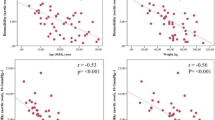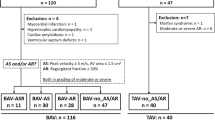Abstract
To determine the relationship between aortic distensibility and left ventricular (LV) remodeling, myocardial strain and blood biomarkers in patients with stenotic bicuspid aortic valve (BAV) and preserved ejection fraction (EF) by cardiovascular magnetic resonance (CMR). 43 stenotic BAV patients were prospectively selected for 3.0 T CMR. Patients were divided into LV remodeling group (LV mass/volume ≥ 1.15, n = 21) and non-remodeling group (LV mass/volume < 1.15, n = 22). Clinical characteristics, biochemical data including cardiac troponin T(cTNT), N-terminal pro-B type natriuretic peptide (NT-proBNP) and creatine kinase isoenzyme (CK-MB) were noted. Distensibility of middle ascending aorta (mid-AA) and proximal descending aorta, LV structural and functional parameters, global and regional myocardial strain were measured. Compared to non-remodeling group, LV remodeling group had significantly decreased LV global strain (radial: 26.04 ± 8.70% vs. 32.92 ± 7.81%, P = 0.009; circumferential: − 17.20 ± 3.38% vs. − 19.65 ± 2.34%, P = 0.008; longitudinal: − 9.13 ± 2.34% vs. − 11.63 ± 1.99%, P < 0.001) and decreased mid-AA distensibility (1.22 ± 0.24 10–3 mm/Hg vs 1.60 ± 0.41 10–3 mm/Hg, P = 0.001). In addition, mid-AA distensibility was independently associated with LV remodeling (β = − 0.282, P = 0.003), and it was also significantly correlated with LV global strain (radial: r = 0.392, P = 0.009; circumferential: r = − 0.348, P = 0.022; longitudinal: r = − 0.333, P = 0.029), cTNT (r = − 0.333, P = 0.029) and NT-proBNP (r = − 0.440, P = 0.003). In this cohort with stenotic BAV and preserved EF, mid-AA distensibility is found significantly associated with LV remolding, which encouraging to better understand mechanism of ventricular vascular coupling.



Similar content being viewed by others
References
Michelena HI, Prakash SK, Della Corte A et al (2014) Bicuspid aortic valve identifying knowledge gaps and rising to the challenge from the international bicuspid aortic valve consortium (BAVCon). Circulation 129(25):2691–2704
Hoffman JIE, Kaplan S (2002) The incidence of congenital heart disease. J Am Coll Cardiol 39(12):1890–1900
Stefek H, Berhane H, Robinson J et al (2019) Comprehensive MR analysis of cardiac function, aortic hemodynamics and left ventricular strain in pediatric cohort with isolated bicuspid aortic valve. Pediatr Cardiol 40(7):1450–1459
Zhang X, Zhu M, He T et al (2015) Cardiac mechanics in isolated bicuspid aortic valve disease with normal ejection fraction: a study of various valvular lesion types. Medicine (Baltimore) 94(47):e2085
Nucifora G, Miller J, Gillebert C et al (2018) Ascending aorta and myocardial mechanics in patients with “clinically normal” bicuspid aortic valve insights from cardiovascular magnetic resonance tissue-tracking imaging. Int Heart J 59(4):741–749
Santarpia G, Scognamiglio G, Di Salvo G et al (2012) Aortic and left ventricular remodeling in patients with bicuspid aortic valve without significant valvular dysfunction: a prospective study. Int J Cardiol 158(3):347–352
Lee SY, Shim CY, Hong G-R et al (2015) Association of aortic phenotypes and mechanical function with left ventricular diastolic function in subjects with normally functioning bicuspid aortic valves and comparison to subjects with tricuspid aortic valves. Am J Cardiol 116(10):1547–1554
Von Knobelsdorff-Brenkenhoff F, Karunaharamoorthy A, Trauzeddel RF et al (2016) Evaluation of aortic blood flow and wall shear stress in aortic stenosis and its association with left ventricular remodeling. Circ Cardiovasc Imaging 9(3):e004038
Kong WKF, Vollema EM, Prevedello F et al (2020) Prognostic implications of left ventricular global longitudinal strain in patients with bicuspid aortic valve disease and preserved left ventricular ejection fraction. Eur Heart J Cardiovasc Imaging 21(7):759–767
Geiger J, Rahsepar AA, Suwa K et al (2018) 4D flow MRI, cardiac function, and T1-mapping: association of valve-mediated changes in aortic hemodynamics with left ventricular remodeling. J Magn Reson Imaging 48(1):121–131
Claus P, Omar A, Pedrizzetti G et al (2015) Tissue tracking technology for assessing cardiac mechanics: principles, normal values, and clinical applications. JACC Cardiovasc Imaging 8(12):1444–1460
Treibel TA, Badiani S, Lloyd G et al (2019) Multimodality imaging markers of adverse myocardial remodeling in aortic stenosis. JACC Cardiovasc Imaging 12(8):1532–1548
Nishimura RA, Otto CM, Bonow RO et al (2014) 2014 AHA/ACC guideline for the management of patients with valvular heart disease: executive summary a report of the American College of Cardiology/American Heart Association Task Force on Practice Guidelines. Circulation 129(23):2440–2492
Lang RM et al (2015) Recommendations for cardiac chamber quantification by echocardiography in adults: an update from the American Society of Echocardiography and the European Association of, Cardiovascular Imaging. Eur Heart J Cardiovasc Imaging 16:233
Sievers H-H, Schmidtke C (2007) A classification system for the bicuspid aortic valve from 304 surgical specimens. J Thorac Cardiovasc Surg 133(5):1226–1233
Guala A, Rodriguez-Palomares J, Dux-Santoy L et al (2019) Influence of aortic dilation on the regional aortic stiffness of bicuspid aortic valve assessed by 4-dimensional flow cardiac magnetic resonance comparison with Marfan syndrome and degenerative aortic aneurysm. JACC Cardiovasc Imag 12(6):1020–1029
Rider O, Nethononda R, Petersen S et al (2013) Concentric left ventricular remodeling and aortic stiffness: a comparison of obesity and hypertension. Int J Cardiol 167(6):2989–2994
O’rourke MF, Staessen JA, Vlachopoulos C et al (2002) Clinical applications of arterial stiffness; definitions and reference values. Am J Hypertens 15(5):426–444
Vahanian A, Beyersdorf F, Praz F et al (2021) 2021 ESC/EACTS Guidelines for the management of valvular heart disease. Eur Heart J. https://doi.org/10.1093/eurheartj/ehab395
Chiam PTL, Ewe SH (2016) The expanding indications of transcatheter aortic valve implantation. Futur Cardiol 12(2):209–219
Makkar RR, Yoon S-H, Chakravarty T et al (2021) Association between transcatheter aortic valve replacement for bicuspid vs tricuspid aortic stenosis and mortality or stroke among patients at low surgical risk. JAMA J Am Med Assoc 326(11):1034–1044
Joseph S, Moazami N, Cupps BP et al (2009) Magnetic resonance imaging-based multiparametric systolic strain analysis and regional contractile heterogeneity in patients with dilated cardiomyopathy. J Heart Lung Transpl 28(4):388–394
Weidemann F, Herrmann S, Stoerk S et al (2009) Impact of myocardial fibrosis in patients with symptomatic severe aortic stenosis. Circulation 120(7):577–584
Ng ACT, Prihadi EA, Antoni ML et al (2018) Left ventricular global longitudinal strain is predictive of all-causemortality independent of aortic stenosis severity and ejection fraction. Eur Heart J Cardiovasc Imaging 19(8):859–867
Blunder S, Messner B, Aschacher T et al (2012) Characteristics of TAV- and BAV-associated thoracic aortic aneurysms-Smooth muscle cell biology, expression profiling, and histological analyses. Atherosclerosis 220(2):355–361
Bollache E, Guzzardi DG, Sattari S et al (2018) Aortic valve-mediated wall shear stress is heterogeneous and predicts regional aortic elastic fiber thinning in bicuspid aortic valve-associated aortopathy. J Thorac Cardiovasc Surg 156(6):2112-2120.e2112
Halloran B, Davis V, Mcmanus B et al (1995) Localization of aortic disease is associated with intrinsic differences in aortic structure. J Surg Res 59(1):17–22
Roman M, Okin P, Kizer J et al (2010) Relations of central and brachial blood pressure to left ventricular hypertrophy and geometry: the Strong Heart Study. J Hypertens 28(2):384–388
Chirinos J, Segers P, Hughes T et al (2019) Large-artery stiffness in health and disease: JACC state-of-the-art review. J Am Coll Cardiol 74(9):1237–1263
Weber T, Chirinos J (2018) Pulsatile arterial haemodynamics in heart failure. Eur Heart J 39(43):3847–3854
Krishnasamy R, Hawley CM, Stanton T et al (2015) Left ventricular global longitudinal strain is associated with cardiovascular risk factors and arterial stiffness in chronic kidney disease. BMC Nephrol. https://doi.org/10.1186/s12882-015-0098-1
Mehta S, Khoury PR, Madsen NL et al (2018) Arterial thickness and stiffness are independently associated with left ventricular strain. J Am Soc Echocardiogr 31(1):99–104
Kociol RD, Pang PS, Gheorghiade M et al (2010) Troponin elevation in heart failure prevalence, mechanisms, and clinical implications. J Am Coll Cardiol 56(14):1071–1078
Vanderheyden M, Goethals M, Verstreken S et al (2004) Wall stress modulates brain natriuretic peptide production in pressure overload cardiomyopathy. J Am Coll Cardiol 44(12):2349–2354
Zhang B, Xu H, Zhang H et al (2020) Prognostic value of N-terminal Pro-B-type natriuretic peptide in elderly patients with valvular heart disease. J Am Coll Cardiol 75(14):1659–1672
Lim P, Monin J, Monchi M et al (2004) Predictors of outcome in patients with severe aortic stenosis and normal left ventricular function: role of B-type natriuretic peptide. Eur Heart J 25(22):2048–2053
Sia CH, Ho JS, Chua JJ et al (2020) Comparison of clinical and echocardiographic features of asymptomatic patients with stenotic bicuspid versus tricuspid aortic valves. Am J Cardiol 128:210–215
Funding
This work was supported by National Natural Science Foundation of China (Grant Numbers:81901818 and 82071991) and Shanghai Municipal Committee of Science and Technology, China (Grant Number:19ZR1451000).
Author information
Authors and Affiliations
Contributions
PY—data collection, analysis, manuscript draft; LJ—study design, manuscript review; WY, LJ—data collection, analysis; XP, ZM—manuscript review; SY—study design, data collection, manuscript review. All authors revised the paper and approved the final version.
Corresponding author
Ethics declarations
Conflict of interest
All authors declare that they have no conflict of interest.
Ethical approval
This study was approved by the local ethics committee of our institution (NO:B2020-232), and conformed to the ethical principles outlined in the Declaration of Helsinki.
Informed consent
Informed consent was obtained from all individual participants included in the study.
Additional information
Publisher's Note
Springer Nature remains neutral with regard to jurisdictional claims in published maps and institutional affiliations.
Rights and permissions
About this article
Cite this article
Pan, Y., Lin, J., Wang, Y. et al. Association of aortic distensibility and left ventricular function in patients with stenotic bicuspid aortic valve and preserved ejection fraction: a CMR study. Int J Cardiovasc Imaging 38, 2025–2033 (2022). https://doi.org/10.1007/s10554-022-02581-4
Received:
Accepted:
Published:
Issue Date:
DOI: https://doi.org/10.1007/s10554-022-02581-4




